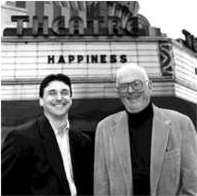|
|
||||||||||
|
|
||||||||||
|
Volume
75
Pitts bequest benefits Candler
The Once and Future Mummy Museum
|
Cinema
in black and white DURING preparations for the opening of the film version of Margaret Mitchell’s Gone With the Wind, director David O. Selznick and Metro Goldwyn Mayer (MGM) studio executives argued over whether to invite Hattie McDaniel, whose portrayal of the slave Mammy was later honored with an Academy Award, to the world premiere at the now-defunct Loew’s Grand Theater in Atlanta on December 15, 1939.
"Selznick said, ‘If merit alone ruled, she would deserve star billing in this film,’ " according to Professor of Urban Studies Dana White, who, with Associate Professor of Film Studies Matthew Bernstein, is currently at work on a history of black film-viewing habits in Atlanta. "Yet MGM’s local distribution man in Atlanta was saying it could cause trouble. So a couple of months before the premiere, they decided, ‘No, she’s not coming.’ " Surprisingly, however, Atlanta’s African-American audiences contributed to the film’s phenomenal success. Almost five months after a record-breaking nine-week run at the white-only Loew’s Grand, Gone With the Wind opened to rave reviews for black audiences at the Royal Theater on Auburn Avenue. "The hometown pride factor could compensate for racism perceived on the screen," says Bernstein. "The gist of reviews in the [black-owned and-operated] Atlanta Daily World was, ‘This film is not as offensive as we thought it would be. It has these racist elements, but Hattie McDaniel is so wonderful.’ " Such contradictory dynamics have united White and Bernstein for a three-year, collaborative project titled "Segregated Cinema in a Southern City: Atlanta, 1895–1996." Their study, funded by the National Endowment for the Humanities, begins with the 1895 Cotton States Exposition in Atlanta, when motion pictures were first shown in the United States, and ends with the 1996 Olympic Games. Much of their work, which will culminate in a book, has focused on the era of public segregation in the city, when Atlanta’s black and white moviegoers saw films at different times in different theaters. The story of Atlanta, they suggest, is reflected and illuminated in the story of its movie theaters and audiences. "This period [of public segregation] is so complex and full of contradictions," says White. "Local pride is a big part of it. People were concerned with race, but also with portrayals of the South." Key to the study, say White and Bernstein, are Atlanta movie theaters and their patrons through the decades, especially during the segregation era. African-American Atlantans generally patronized several "colored" theaters—including the working-class Eighty-One on Decatur Street and the more elite, "top-hat" Royal. Only the Fox and the Roxy theaters in downtown Atlanta permitted black patrons in segregated balcony seating. "Theaters were segregated until 1962," says White. "Then downtown Atlanta started changing and downtown theaters dying. That was also the year the Peachtree Center really took off, when [architect John] Portman built the Peachtree Plaza Hotel. The theater on that block was wiped out." Toward the end of their project, White and Bernstein plan to look at the premiere of Driving Miss Daisy in 1989. "You have the same issues: Atlanta’s hometown pride, race relations, everything," says Bernstein. "Whenever you have these special events or controversies, such as censorship—when the system breaks down—that’s when the public attitudes really emerge and you see how things were." —A.O.A. |
|||||||||||||||
